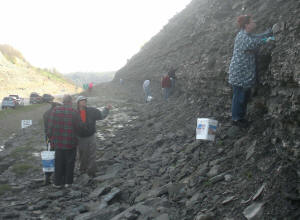
The first outdoor field trip of 2012 was a return to a huge road cut in northeastern Kentucky that has consistently turned up great finds. The site is so big, it exposes much of the Kope formation at the bottom, the entire Fairview formation in the middle and the Bellevue format at the top. The site is well documented in field guides from local universities. It is frequented by college and professional field trips.
Today the turnout was somewhat light compared to past trips here. This was due to the threat of rain in the forecast. But the field trips are always rain or shine because you never can tell by the time you get there what's going to happen with the weather. As is often the case, we found the sky clearing and good pickin's on the site.
Fossils Found That Day
Best Finds of the Day
Crinoids
Quite a few calyxes (heads) of the Kope Formation crinoid
Ectenocrinus
simplex.
Rick Schrantz had found a great pocket of crinoid calyxes in a previous trip and went back there today to collect a box lid full of more specimens. These crinoids are Glyptocrinus decadactylus.
The above specimen is actually nearly complete inside the matrix, as Rick Schrantz discovered when he prepared the specimen. See next 4 photos (by Rick Schrantz).
Often you will just find a little bit of the crinoid arms
sticking out from the shale, like in the photo below. A good eye and a loupe
helps in finding these treasures.
We found several types of crinoid holdfasts that day.
One type of holdfast is where the stem wraps around the stem
of another crinoid. (next 2 pics)
Another type of crinoid holdfast, called
lichenocrinus,
is where the crinoid has a base that encrusts a hard-ground or other solid
object.
Most often though, we found crinoid stems loose weatheing out
of the clay and locked tightly on the surface of rocks. (next 2 pics)
Scolecodonts (Worm Jaws)
One of the best finds was a couple of slabs with Scolecodont elements all over it. The member who found this needs to show these to Rich Fuchs, our resident Scolecodont expert.
Other Microfossils
As is true of most sites exposing the Fairview formation,
there is a layer of tiny gastropods named Cyclora, that are easy to find because
the layer is reddish in color. This layer often has lots of the small
brachiopod, Cincinnetina, in it. It looks as though the reddish color comes mostly
from iron deposits of the water which seeps through this grainy layer more
easily than the limestone layers above it and below it.
Trilobites
We didn't have anyone that found a whole, articulated Isotelus trilobite this time. We did have the next best thing - a large group of fragments that, if put back together with glue, would be most of the Cephalon (head). I assisted Sharon Wachter, who found the assemblage, record the position of each fragment and then carefully load all of the fragments into a box, where there is a small hope that many will fit together to form a very nice specimen! (next 3 pics)
Other individual fragments of Isotelus trilobites were found. This first one is the hypostome (mouth plate).
Here is a thorax segment of an Istotelus trilobite.
This next Istotelus fragment looks like it's from the pygidium.
These next two pictures are of individual segments of a thorax
of Flexicalymene.
Bryozoans
We found some great bryozoans that are mostly limited to the
Fairview formation. Here's a cood example of the hard to find Bryozoan Graptodictya perelegans.
Another hard to find Fairview Bryozoan found was Escharopora hilli.
It's a long tapering bryozoan with ridges and triangular shaped monticules.
An uncommon bryozoan to a lesser degree is this fenestrate
Bryozoan.
This next bryozoan is easy to recognise by its star-shaped monticules. It's Constellaria florida. It too is mostly found in the Fairview.
Bryozoans abound on this site. Here are just a few pictures of some.
Trace Fossils.
The most common trace fossil we found was examples of a worm
burrow that has a bit of a dumbell shape called Diplocriterion. (next 4 pics)
Brachiopods
Most of the layers we visited that day exposed the Fairview
formation. We found a brachiopod that is mostly found in the Fairview and can
help you determine if you are in the Fairview - Plectorthis.
The largest and most common brachiopod in the Cincinnatian
tri-state area was also commonly found on this site - Rafinesquina.
Near the top of this site is exposed the Bellevue formation.
Here you find lots of the big brachiopod, Vinlandostrophia
ponderosa. (next 3 pics)
A less common but easily found brachiopod, also found in the
Bellevue is Hebertella.(next 2 pics)
A tiny brachiopod found in great abundance was Cincinnetina multisecta.
Pelecypods (clams)
A particularly nice clam we found was this Ambonychia.
Here's a slab with two kinds of bivalves: the two on the left
are Caritodens and the one on the upper right is Ambonychia.
Straight Shelled Nautiloid Cephalopods
Now let's see the photos from the April field trip to one of our most favorite Richmondian sites.
See some of our previous trips to this site.
September 2009
March, 2008
September 2005
April 2005
Sept. 2003
Back to the Field Trip Index Page
Return to Dry Dredgers Home Page
The Dry Dredgers and individual contributors reserve the
rights to all information, images, and content presented here. Permission to
reproduce in any fashion, must be requested in writing to admin@drydredgers.org.
www.drydredgers.org is designed and maintained by Bill Heimbrock.